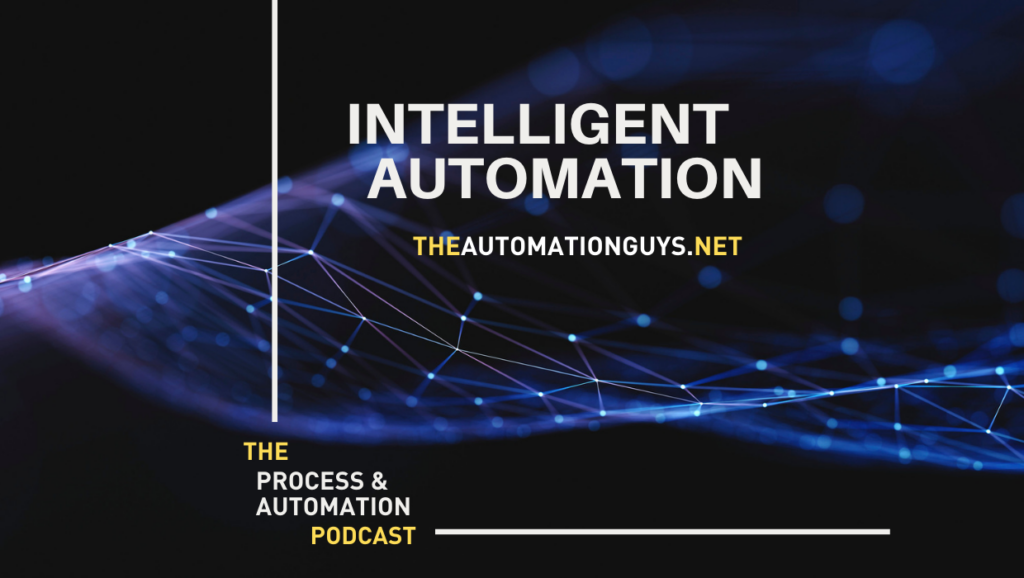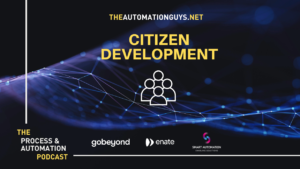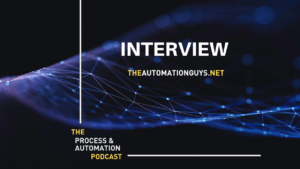Blog

What are the cost benefits of Low-Code vs. Traditional App Development? In Part 1 of the 2-part episode of the Process and Automation podcast you will find out exactley this and why you should consider starting your low code journey today!
Share This Post
Start here –> https://theautomationguys.net
Do you have any questions? Would you like to give us feedback? Are you interested in workshops on the topic of automation? Are you an expert in the field of automation and would like to be on the podcast?
LinkedIn Arno: https://bit.ly/3aABArd
LinkedIn Sascha: https://bit.ly/36Jd31T
Velocity-IT: https://www.velocity-it.com/about-us/
convedo Group: https://www.convedo.com/about-us
Episode Transcript
Hello. And welcome back to another episode of the process and automation podcast with the automation guys. In today’s episode, we will cover an interesting question we get from our listeners a lot. So what are the cost benefits of low code versus traditional app development methods and, um, yeah, for this, um, to answer this question, uh, we, we will also cover sort of some basics.
Um, you know, so as you know, most companies have opted for custom made software development over the years. So, so the traditional coding, as you know, it, I’m sitting in the basement with lots of pizza, but it’s started to give way to local development is a very viable option and, um, And did this viable because Forester states, um, in general, uh, is faster development.
Um, um, and this is why it’s so attractive 10 times faster. And because of that, the local development market is growing at the rate of nearly 50% year to year. So this, this is incredible and, uh, and, and somehow own line was what other analysts say in general about the growing automation market. So one question to answer is really what is, what is low code app development?
So we were talking about this a lot here on this podcast. And I also have chats about low code on clubhouse, uh, regularly on a weekly basis. And yeah, low code is one of those newer approaches to build business applications and, um, and building business applications quickly. So that’s in terms of comparison to traditional development, um, do you, you don’t have to write.
Um, coat in a line by line, in the normal normal way. So you completely avoid this. So it’s, it’s a white develop, develop applications very, very quickly. It was sort of a minimal hand coding, drag and drop. Usually you have a visual visual kind of editors, not editors, visual I’m way off of building your applications.
One, one thing to. Probably compare it. Twos is building, building websites these days. So back then you had to ask someone to do your HTML coding. And these days when you build a website yourself or your club or so, um, you can just drag and drop everything. So everything is done for you. And this is very similar with business applications and low-code app development.
So you can really work from existing building blocks at 16, 10 templates that have been produced by the, um, by the vendors or some partners of these vendors. So they, they create this ready to go components, drag, and drop pre-build elements, and you can very easily build your forms and objects. And, um, you’re basically you get, you get this working application in and yeah, it was less hassle and less time.
And. Yeah. And that basically means. Um, development can be handled by even those with limited coding knowledge. Um, so, so the so-called citizen developers, that’s, that’s a term you probably hear more and more because of these predesigned elements. Um, so you can customize or configure them rather than you actually need to develop.
So, um, yeah, so that means both developers and non-developers can use low code because local means if there is a situation you need to do a bit more in depth stuff, you can go still into a coding mode and, uh, and get stuff done. Um, and otherwise you just use the low code components, no code components even.
And, um, Less training to get started. Really? So your whole team can just put these ideas they have into, into, into application. Yes. Um, of course with like Sasha mentioned with Loco development, it is very easy to get started. It is, uh, using, um, building blocks to assemble applications, uh, very quickly. Um, and there’s, there’s a lot of benefits in doing so, because.
Of course, you know, one of the benefits is that, um, local development has this potential to decrease the time. Um, it’s, it’s it takes to, um, meet business requirements when you build up these, these apps and like Sasha mentioned, um, you know, according to Forrester research, um, using low code, um, can accelerate development times tenfold.
Uh, compared to traditional app development methods. And this allows for really kind of. Delivery for a minimum viable product. And of course you can take that product and then evolve it by using, uh, you know, user feedback. You know, you can get something out there and, um, you know, get feedback from your end users and transform this into a sort of a product that fulfills their needs over time.
And, you know, local is a great way to. To a digital transformation with inside companies. Um, you know, you can automate tasks using very simple applications and, you know, companies save time in doing so where they shift the resources away from, from the manual work they would normally do. Um, that’s associated with, um, you know, manual processes.
Um, and of course, you know, if you compare low-code with traditional app development, traditional app development might take too long and cost too much what it might not be kind of worth your while in terms of effort, uh, for the development teams, um, to, to, to engage with these, these. Projects, um, because they, there might be other higher business priorities.
So, so low code is a perfect way that you can kind of slot, um, these, these, these sorts of projects into your backlog deliver very quickly use some of the, the business people’s knowledge to deliver these apps. And provide value. Um, and you know, like we know it teams are often very over loaded with backlog and they understaffed, uh, in, you know, in, in the amount of work they’ve already got.
So Loco really allows these people to. Um, uh, or, you know, allow these projects to be created, uh, very quickly, um, without tying up these expensive, highly skilled development teams. Um, you know, we always described it as sort of a best of breed shadow it solution where you bypass some of the, the it development team completely.
Um, and you know, you could, you could build the solutions pretty fast within SIDA, uh, sort of a, um, I guess a controlled environment. And again, you know, staffing development teams can be quite expensive. Um, and you know, there is a shortage of developers out there. You know, uh, and your average kind of salary for a software developer of the senior person that writes traditional code, um, is around the sort of 80 to a hundred thousand dollars a year market.
So that’s quite quite expensive. And, you know, if you take sort of, uh, the benefits that person has on top of that workspace cost hardware software, you know, that that’s quite a big cost for a business. So low code development really. Um, allows you to sort of, uh, um, I guess, bypass some of those costs by allowing sort of, um, these, these low level applications develop developers, really to, to, to engage in development as well, to solve their problems and really kind of taking this out to the masses and alleviating some of that.
Um, I guess, uh, you know, the precious on, on, on, on these sort of it staff, you know, the technical develop. Yeah. And it’s not necessarily just a cost. I think if you, even if you have the budgets available, I think it’s really difficult to find the very, um, skilled software developers out there. So, so you currently we argue or not argue, we, we hear more and more every day in the news, we have this digital skills gap, uh, everywhere.
Because of automation, everyone wants to digitalize their business, wants to automate their business. And obviously every, every business is looking for these skills in the market. And currently there’s a such a big gap. Um, so if you, if you only looking for software developers and then. Traditional sense.
Yeah. You, you will not find them or they even more expensive than what Arnaud mentioned. Um, uh, so they’re very, very much in high demand. There’s always sort of competition, uh, head hunters coming, coming around. So, so, so this will always be then a problem. If, um, if, if this will be the way of developing, um, I think low code is.
The, I was really giving that chance to, to even, um, uh, it grads coming in if they upskilled to, to jump onto low code development projects. Um, and, um, fill that gap. Um, I think there’s an agenda, not just low code apps. There’s so many low code areas. These days, RPA chatbots, low code AI, low code process mining.
So everything comes as local these days and it, it is perfect for, for, for this new. Sort of the new type of, uh, uh, of talent coming through, but there’s talent has to be prepared for, for, for what, what is coming currently. We have that huge gap and I think that leads as well to, um, to the potential pitfalls was low-code app developers.
So if you, if you allow sort of a wider pool of people to develop applications, sort of super users within departments, it gradients coming in it’s it’s yeah, it might be easy to lose control over, over governance. So everyone is. Building apps because they have great ideas on the way to work on the commute.
They thinking about how they can improve their, uh, department, how they can get rid of this excellent email workflow so that they come up with all these ideas and they want to get going. Um, but without these strict controls and guidelines within the organization, the it department will usually make sure everyone adheres to them too, to a certain extent without sort of slowing that innovation.
But it’s very important to, to follow these strict control roads, uh, controlled search protocols and guidelines was in that organization. So applications. Are not becoming a mess, um, and are not very difficult to scale when they actually go live. So that’s, that’s very important to, to look at. So yeah, because of low code app platforms out there, and these buttons use common components and prebuilt sort of modules there.
I think, yes, there’s much less ability to customize. I think so. Yeah. It’s, it’s a pro and con was these two worlds. Um, this is why low code rather than no code is more the thing, because it just doesn’t give you that specific component. And that’s, it’s very often that allows, uh, sort of the more, more advanced.
Uh, developer to customize it, but still in some aspects you have to use the platform as it is very often when it comes to user interface, some style elements, and some, some structures are very, very, um, Yeah, they are given. Um, and usually it’s not a problem. So you can always find ways to, to make this attractive to the business.
Sometimes the business, they want to have a hundred percent control over every pixel and position, but, uh, but yeah, it may, it may prevent you from getting the exact functionality or integration you need. Um, yeah. And in traditional app development, you, you’re only limited by the sort of. Yeah, by the skill level, the expertise of the developers that I can just open up a sort of a visual studio or another development platform and just start coding and they can do pretty much everything, but yeah, some of this local platforms.
Yeah. So it’s, it’s, it’s a bit limited. And, uh, I guess it helps in the governance, right? Because it provides those guide rails, less box isn’t it? So if you start writing lines of code immediately, where every line of code is a potential place for bug, and if you have that wrapped up and integration into an ERP system, usually that’s quite complex.
If that is already there, it’s a building block is a Lego block. We might say it’s quite easy to use. And this is, this is sort of. Um, you, you’re pretty sure this is not a place where the buck occurs anymore because it’s tested and, um, uh, by lots of comms companies and customers. Um, yeah, and I would say, uh, yeah.
Uh, for local platforms is sort of a, you you’re locked in with the vendor. Um, so some of these platforms that come to give you the cloud platforms ready to go, you can do everything on it. Uh, you bill all your applications on it. Um, you know, if it Def environment managed, test environment, managed production environment, manage very easy, no hassle really there, but.
Yeah. If you, if you, if you like that idea, you building out hundreds of processes within your organizations, you’re not gonna have just one, uh, purchase to pay application. Maybe that’s where companies usually start was a small, small kind of proof of value. But if, if there is excitement there. Usually that, that extends to hundreds of process applications.
Um, yeah. And then potentially locked in. So depending on a platform, yeah, you, you you’re locked in into this underlying code. Um, you can’t work outside of that platform. Um, so yeah, so you can’t even use very easily, um, uh, like a tool to switch into a new platform. So once these applications was this low code, Yeah.
If you take it out very often, you can’t really take it out, but it wouldn’t work with a sort of run runtime that that vendor provides. So, so that’s, that’s, that’s why it’s crucial, um, to evaluate licensing and portability when choosing a local platform. But I think generally if the business value is so much bigger, um, then potentially those kinds of issues then, um, maybe it’s not even, yeah.
Well, I think it use it where it needs to be used at a specific sort of level. Right. So if they are, um, use cases where you can. Parsa low-code platform to the business users to assemble a workflow or a digital form to solve a particular problem. And that’s the scope of that requirement then that’s great because you know, you, you are providing this person with the ability to solve that problem.
You know, with inside your governance frameworks, um, it might only be internal facing, so there might be some limitations on how it looks and how it behaves, but it’s still one less problem with inside your business. You know, there might be other problems which is customer facing problems, where it’s not necessarily just up to a business user to solve that perhaps this business user understand the concepts of low-code.
And how to create a minimal viable product, but they might need some kind of deeper expertise within Loco to create some additional sort of low level implementation that, that uses a bit of scripting or coding to solve specific problems that makes them make this fit for purpose. To, to, um, you know, to put in front of, uh, you know, your customers, for example.
So again, it’s, it’s kind of putting that. The solution to the problem, um, next to the type of problem you have and who uses it. Um, and I think that, of course, you know, you’re not going to rely on citizen developers to create a very strategic system using low code. That will be a blend of people. Um, but at the same time, you might have some very elementary problems that business people can fix using low code, and you want to give them those tools to do so.
Um, so I, so I guess it’s kind of like choosing this right approach for you as a business. Um, and you need to look at the scope of the project to understand, you know, what, what type of tool. Need to, uh, use, um, and what type of skillset do we need to deploy, um, or mobilize to, to implement, um, a particular solution for a problem.
And, uh, you know, I think that you need to look at low code as, as one of those options in the box. Um, to understand, you know, what, what sort of expertise do I need to solve this problem? You know, what’s the nature of this problem. And, um, you know, at least it is another development option for you to accelerate your development, um, and to, you know, get a very cost-effective solution to, to solve specific, um, you know, prompt a specific problem using low code.
Um, so it’s, it’s, it’s a very competitive. Uh, capability with inside a business. Um, I always liked the Lego analogy. You have a problem. You can assemble a solution very quickly using drag and drop constructs. You can take advantage of, um, The, uh, the capabilities that’s inside the box in terms of security, uh, login controls, reporting controls, data, persistence frameworks for case management, um, you know, frameworks for document approval frameworks for document management, frameworks for communication, automated responses, task management, frameworks to present tasks on.
Uh, mobile phone, for example. So if somebody receives a task, you know, it’s not just something that lives on their desktop somewhere. It is something that could have, and their mobile phone as well, and action, and mobile phone. And then, and of course, you know, not just stopping with. Traditional low-code workflow automation, also looking at Loco chatbots, looking at RPA, you know, that’s all low code as well.
So it’s really kind of all of these different technical capabilities that you could use to assemble a solution to a problem. And these types of technical capabilities, you could put this in front of people with various degrees of skill, and obviously the. The complexity of the type of problem they would solve is, is a function of that skillset.
Um, so if you do have somebody that wants to, uh, create a very simple document approval workflow, integrate DocuSign, or a simple workflow where it gets, uh, the document gets routed to, uh, various people, you know, that’s a great use case for a citizen developer. To uh, to create, right. Um, if it’s a more complicated problem that perhaps you could use Loco to accelerate development, but you still need integration into a third party system.
Then of course you, you might need, um, expert expertise of a more technical person. So you could have a scenario. We have a blended team of business people kind of. Uh, configuring the user journeys. They are elements in there where they need to engage somebody that’s more skilled up in integration to help them configure that part of, of, of the block, the building block.
Um, and then, you know, rapidly assembled this solution, you know, using the outputs of all of these various parties working together. So again, for me, it’s, it’s this. Ultimate kind of collaboration tool where people can do what they can do within the skills. They’ve got to accelerate development without writing code or minimum code and, you know, with inside it governance and where there are complicated bits that needs to be integrated to solve more advanced, uh, problems.
Like I said, integrations, for example, Create a better refined product and a better refined output. Then of course, you know, you need that kind of more technical skill, but again, collectively it re it reduces that burden on it. It accelerates that time to market to, to, to these solutions. It makes a difference to, you know, how people solve their problems and how quickly these problems solved.
And it’s all positive steps in the right direction, you know, and I think that’s, that’s the, that’s the kind of right approach for me that, that kind of nice blend of all of these tools that you, that you use together, um, to solve these business problems really cost effectively. And, you know, some people argue and say, well, there is a licensing cost, but I think if you look at the overall overarching business, Um, and you are very firm on that, the kind of benefits that you want to reap from the low-code platform and you really, um, adopt it quite aggressively.
The investment in license quickly diminishes. When you look at the return, the product provides you in terms of business benefits. And this can be hard returns where, you know, you do actually save people’s time. That’s the FTE costs, right. That, that potentially, you know, could offset the impact or the cost to do your licensing of your local platform.
Unfortunately, that’s it again with this episode of the process and automation podcast. If you liked this episode, please give us a five-star rating and don’t forget to subscribe to this podcast so you don’t miss any upcoming episode. We hope you’ll tune in next time. And until then let’s automate it.
- May 25, 2021
- 8:46 pm


